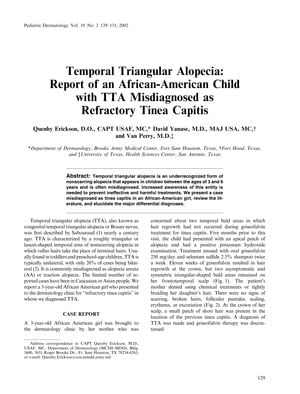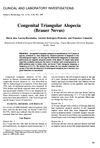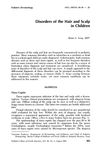Temporal Triangular Alopecia: Report of an African-American Child Misdiagnosed as Refractory Tinea Capitis
March 2002
in “
Pediatric Dermatology
”

TLDR A child was initially wrongly diagnosed with a fungal scalp infection but actually had a non-scarring hair loss condition called Temporal Triangular Alopecia.
In 2002, a case report was presented of a 3-year-old African-American girl who was initially misdiagnosed with refractory tinea capitis, a fungal infection of the scalp, but was later correctly diagnosed with Temporal Triangular Alopecia (TTA). TTA is a nonscarring, nonprogressive form of hair loss that typically presents in children between the ages of 3 and 6 as a discrete, triangular-shaped patch of hair loss on the temporal aspect of the scalp. The girl had been treated with oral griseofulvin and selenium sulfide shampoo for an apical patch of alopecia with a positive potassium hydroxide examination, which resulted in hair regrowth at the crown but not in the temporal areas. Upon closer examination, the temporal bald areas were found to be asymptomatic and symmetric with no signs of scarring, broken hairs, or follicular pustules, leading to the diagnosis of TTA. The report emphasized the importance of recognizing TTA to avoid unnecessary and potentially harmful treatments, noting that hair restoration techniques are the only known effective treatment, with no reported efficacy of topical minoxidil. The case highlighted the need for increased awareness and proper diagnosis of TTA.


